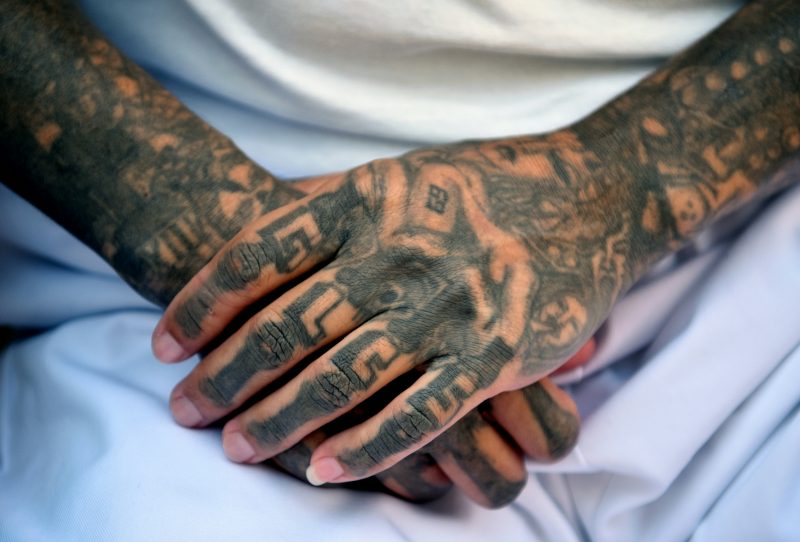Salvadoran ex-gang members dream of removing telltale tats
An ex-member of the feared MS-13 gang is pictured at the prison in Santa Ana, northwest of the Salvadoran capital (Oscar Rivera)
Santa Ana (El Salvador) (AFP) – Their skin looks all but taken over by endless intricate tattoos. Many of El Salvador’s reformed gang members now desperately want a chance to laser-erase this outward evidence of their fearsome past.
Sector One of Apanteos Prison, a medium-security facility in Santa Ana, near the capital, houses 239 men, most former members of the Mara Salvatrucha (MS-13) and Barrio 18 gangs, who say they have gone straight for good.
Aged 24 to 48, they are serving time for homicide, drug trafficking and extortion convictions. Their terms range from six years to six decades.
Like many ex-gang members, Carlos Ruballo, formerly of MS-13, is covered in sprawling ink used as a sort of terror trademark. These tats, typical of the criminal group, were meant to turn him into a visible symbol of the gang’s power and reign of terror.
“My dream is to get rid of all these letters I have on me. I’m just covered on my back and abdomen,” Ruballo told AFP. At 41, he has served 15 of a 36-year sentence for aggravated homicide.
Ruballo said he would gladly submit to the intensely painful laser erasing process.
Others in the same boat, keen to distance themselves from their past, are left with no other option than to ink a massive “X” over the gang tats in symbolic rejection.
Born on the streets of the US city of Los Angeles in the early 1980s, MS-13 and Barrio 18 now strike fear into communities in this impoverished Central American nation, trafficking drugs and extorting people, while often recruiting new blood by force.
Gangs in El Salvador have some 70,000 members, of whom about 17,000 are behind bars.
Ruballo’s face, neck and arms are virtually covered by the tattoos he started having done at age 13. But he knows that all the pain that went into getting them may pale in comparison to having them erased.
Removing a single tattoo with a laser takes several sessions.
So “it could take years” to erase all the tattoos, explained Mayde Ramirez, a doctor who leads a government clinic where former gang members no longer in jail can get the ink removed.
Paying for tattoo removal in private clinics is costly and well out of reach for most.
– Tattoos’ Meaning –
“Tattoos in the gangs are about identity, and symbolic affiliation that represents part of its subculture,” says social researcher Jannette Aguilar.
Gang members also often have ink “that tells their life story, about important people, and also about death,” given their many violent crimes, she said.
While a tear stands for a murder that was committed, a cross signifies mourning for a fallen comrade, a face with long hair is a girlfriend, and a clown represents a fun moment.
In recent years, tattooing has stopped being a requirement in an attempt to evade persecution under the government’s tough anti-gang strategy, said Aguilar.
Regardless of facts and circumstances, if a suspect has gang tattoos, police often think the individual may as well be guilty, Aguilar said.
– Youthful mistake –
Retired members also are keen to erase tattoos so as to go unnoticed by rival gangs, and to avoid stigmatization in general society, such as when applying for jobs.
Nelson Maximiliano Argueta, 41, another former member of MS-13, has been imprisoned for 20 years for homicide. He knows that one day he will be free and that he has to be ready to rejoin society.
But that is going to take removing the tattoos which on the outside will expose him to danger: the other gangs’ wrath.
“I feel bad walking around with these things on me, because I am no longer part of this. But these are youthful mistakes,” Argueta says, showing the dense designs covering much of his body.
Disclaimer: Validity of the above story is for 7 Days from original date of publishing. Source: AFP.


